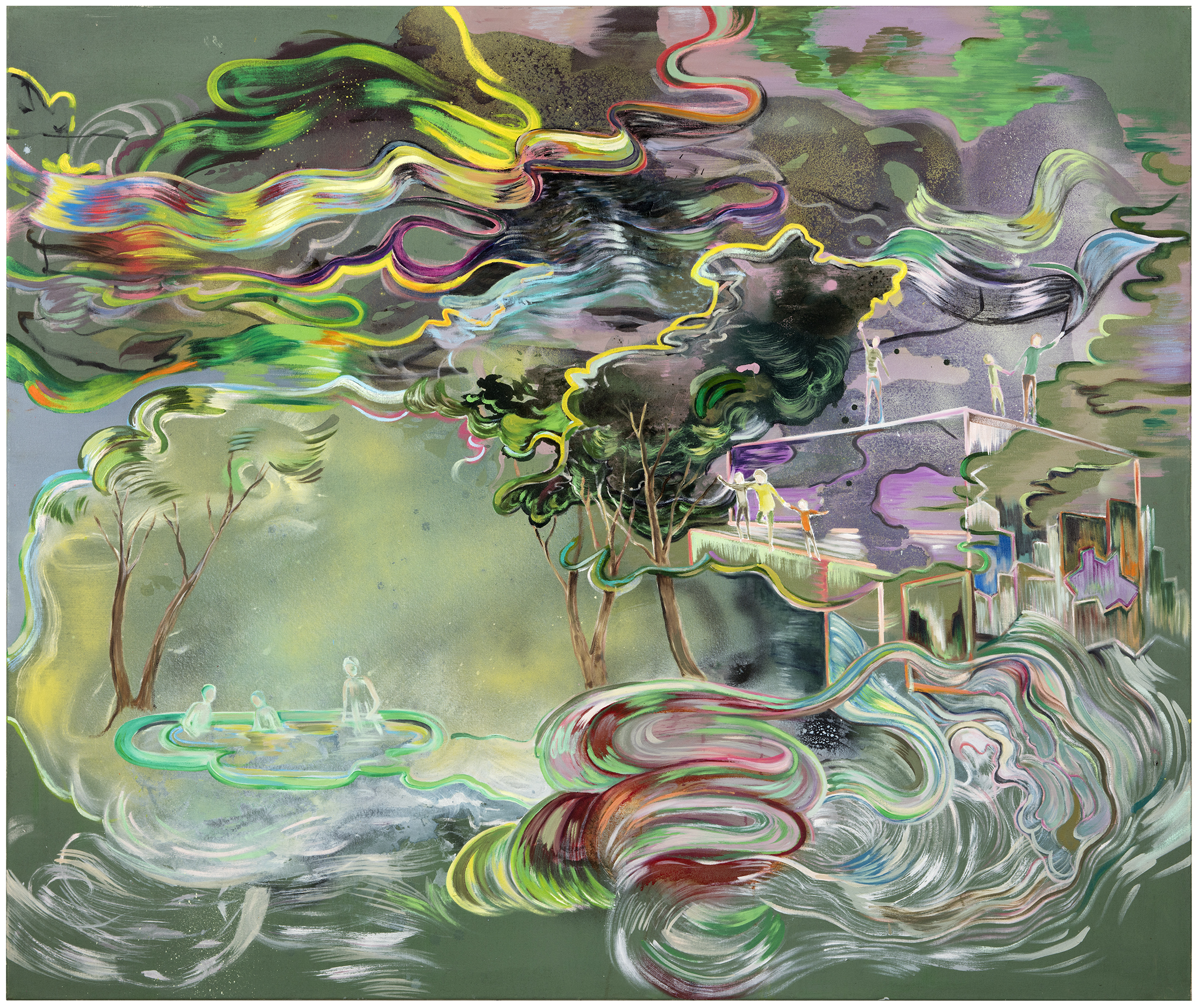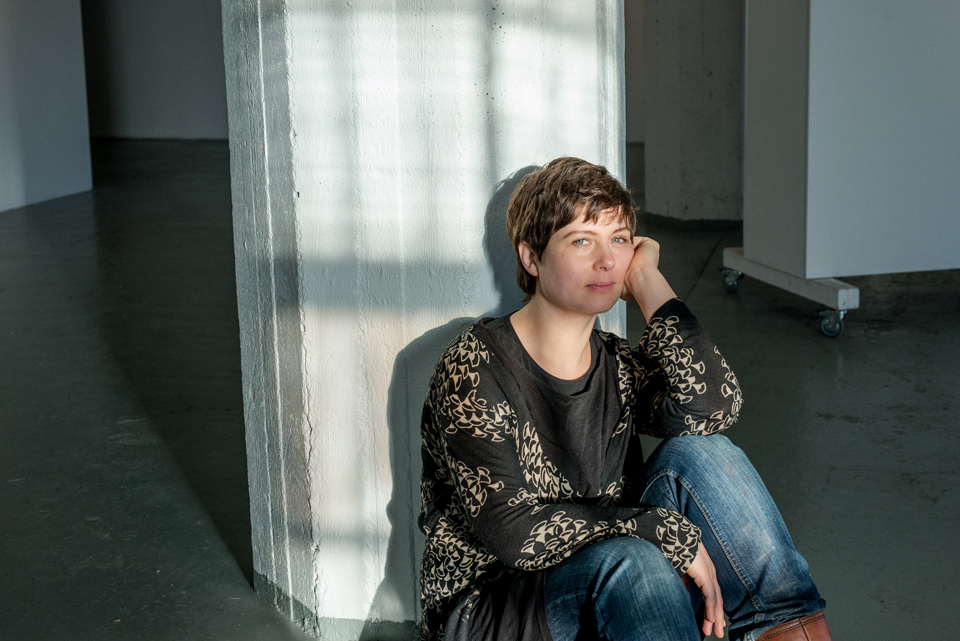
Maiju Salmenkivi’s solo exhibition Overlook is an exploration of memories, remembering, and the passage of time. The title refers to a lookout point, to disregarding something, and to looking down on something from above, but also to the hotel in Stanley Kubrick’s film The Shining.
Salmenkivi began working on the exhibition after seeing her cousin’s photographs of her grandfather’s hotel in Vaasa. The ruined hotel was the landscape of Salmenkivi’s childhood holidays – in the 70s and 80s, the family did not go abroad, but took the train to Vaasa and the hotel. It had a bath and a free soft-drinks machine. She returned to the neglected hotel, which had stood empty for ten years and was in a bad state. Snow had fallen in the corridors from broken skylights, hotel papers were scattered about the place, and campfires had evidently been lit indoors. Her mind filled with memories of childhood, contrasting sharply with the current situation, while she also noticed she was thinking about Kubrick’s The Shining from 1980, which she saw for the first time as an 11-year-old, peeping out from behind a sofa.
Films served as reference points in two of Salmenkivi’s exhibitions of the start of the 2000s. This time, the atmosphere of her own family’s hotel and of the Overlook Hotel exerted a psychological pull. What journey in painting could she take through these images and atmospheres?
The exhibition paintings show remnants of both her grandfather’s hotel in Vaasa and the room in The Shining, where the main character is faced with something unexpected. The themes of having a bath, swimming pools, rooms, corridors and garden vistas become intertwined, as memory images shift from fiction to fact, from allusive to concrete, and from imagined to experienced. The film’s mysterious room with its arched door frame forms a strange new space, a place to do and try things out freely. Not even the artist can explain everything: “Paintings always end up having quite a lot of stream of consciousness, and unprocessed issues from somewhere come face to face with life. From the past, from the moment, from future hopes and concerns.”
The paintings, made with oil, acrylic and spray paint in Salmenkivi’s characteristic fashion, are intensely colourful, and have a spatial quality, and especially motion. The tones in these paintings made on coloured grounds use more broken colours than before and, alongside the works on canvas, there are also paintings on paper and small collages. In the collage-like paintings in the Aarre (Treasure) series the different levels emerge through gaps, prompting thoughts of the stage-set-likeness also seen in other works, which evokes cinematic references. The exhibition hanging alternates large and small works, like memories that change in shape and intensity.
Maiju Salmenkivi's (b. 1972) works were last seen at Helsinki Contemporary in the Happy Garden solo exhibition in 2017. Her works have been seen in Finland and abroad, in both solo and group exhibitions, most recently in the group exhibitions The Only Way is Up at Kunsthall Stavanger, Norway (2016), and Sensual Knowledge at the Landskrona Museum, Sweden (2017). Her works are in the collections of Saastamoinen Foundation, Museum of Contemporary Art Kiasma, Amos Rex, Turku Art Museum, the Jenny and Antti Wihuri Foundation, and elsewhere.
Maiju Salmenkiven yksityisnäyttelyssä Overlook pureudutaan muistoihin, muistamiseen ja ajan kulumiseen. Nimi Overlook viittaa näköalapaikkaan, huomiotta jättämiseen ja yläpuolelta katsomiseen, mutta myös Stanley Kubrickin Hohto-elokuvan hotelliin.
Salmenkivi ryhtyi työstämään näyttelykokonaisuutta nähtyään serkkunsa ottamat valokuvat vaarinsa hotellista Vaasassa. Raunioitunut hotelli oli taiteilijan lapsuuden lomamatkojen maisema – 80-luvun taitteessa perhe ei matkustanut ulkomaille, vaan junalla Vaasaan ja hotelliin. Siellä oli kylpyamme ja ilmainen limuautomaatti. Salmenkivi palasi kymmenen vuotta tyhjillään seisoneeseen, huomiotta jätettyyn hotelliin, joka oli päässyt huonoon kuntoon. Käytäviin oli satanut lunta rikkoutuneista valoikkunoista, hotellin paperit olivat pitkin poikin ja sisällä oli ilmeisesti poltettu nuotiota. Muistot lapsuudesta valtasivat mielen, ne rinnastuivat ristiriitaisesti nykypäivään ja samalla Salmenkivi huomasi ajattelevansa myös Stanley Kubrickin elokuvaa Hohto vuodelta 1980, jonka hän näki ensimmäistä kertaa 11-vuotiaana, sohvan takaa kurkkien.
Elokuvat ovat olleet referenssinä kahdessa Salmenkiven 2000-luvun alun näyttelyssä. Tällä kertaa oman suvun hotelli sekä Overlook-hotellin tunnelma tuntui psykologisesti koukuttavalta. Millaisen matkan voisi kulkea näiden kuvien ja tunnelmien kautta, maalauksen keinoin?
Näyttelyn maalauksissa näemme jäänteitä sekä vaarin hotellista Vaasassa että Hohto-elokuvan huonetilasta, jossa päähenkilö kohtaa jotakin odottamatonta. Aiheina kylpeminen, uima-altaat, huoneet, käytävät ja puutarhanäkymät nivoutuvat yhteen muistikuvien liikkuessa fiktiosta faktaan, referenssistä konkretiaan, imaginäärisestä koettuun. Elokuvan mystinen huone kaariovineen muotoutuu oudon ja uuden tilaksi, paikaksi, jossa voi tehdä ja kokea vapaasti. Kaikkea ei edes taiteilija voi selittää: ”Maalauksiin tulee aina aika paljon sellaista tajunnanvirtaa ja käsittelemättömiä asioita jostain kohtaa elämää. Menneestä, tästä hetkestä, tulevista toiveista ja huolista.”
Salmenkivelle tunnusomaisella tavalla öljy-, akryyli- ja spraymaaleilla toteutetut maalaukset ovat värikylläisiä, niissä on tilallisuutta ja etenkin liikettä. Värillisille pohjille tehtyjen maalausten sävyt ovat aiempaa murretumpia ja kokonaisuudessa on kankaalle maalattujen teosten rinnalla paperille tehtyjä maalauksia ja pieniä kollaaseja. Aarre-sarjan kollaasimaalauksissa eri tasot avautuvat aukkojen kautta ja vievät ajatukset muissakin teoksissa nähtävään lavastemaisuuteen, joka kytkeytyy elokuvalliseen referenssiin. Näyttelyn ripustuksessa isot ja pienet teokset vuorottelevat, kuten muistot, jotka muuttavat muotoaan ja intensiteettiään.
Maiju Salmenkiven (s. 1972) tuotantoa nähtiin viimeksi Helsinki Contemporaryssa Happy Garden -yksityisnäyttelyssä 2017. Salmenkiven teoksia on nähty Suomessa ja ulkomailla sekä yksityis- että ryhmänäyttelyissä, edellisen kerran ryhmänäyttelyissä The Only Way is Up Stavangerin taidehallissa (2016) sekä Sensual Knowledge Landskronan museossa (2017). Hänen teoksiaan on edustettuna muun muassa Saastamoisen säätiön, Nykytaiteen museo Kiasman, Amos Rexin, Turun taidemuseon ja Jenny ja Antti Wihurin rahaston kokoelmiin.
Maiju Salmenkivis separatutställning Overlook fokuserar på minnen, på att minnas det förflutna och på tidens gång. Utställningens titel Overlook kan syfta dels på utsikt över någonting, t.ex. ett landskap, eller att förbise någonting, dels också på hotellet i Stanley Kubricks berömda film The Shining.
Salmenkivi började arbeta med utställningen efter att ha sett fotografier som hennes kusin tagit av hennes morfars hotell i Vasa. Salmenkivi tillbringade sina bardomssemestrar i hotellets landskap – på 1970- och 1980-talen gjorde familjen inte utlandsresor, utan åkte med tåg till Vasa och hotellet. Där fanns badkar och en gratis läskautomat. Hon återvände tio år senare till hotellet, som hade förfallit efter ha stått tomt utan skötsel. Snö hade fallit in genom trasiga takfönster, hotellets papper och dokument låg utspridda överallt och man kunde se spår av brasor inomhus. De barndomsminnen som fyllde hennes sinne stod i bjärt kontrast till vad hon nu såg. Samtidigt märkte hon att hennes tankar också gick till Stanley Kubricks film The Shining från 1980, som hon såg första gången som elvaåring, gluttande bakom soffan.
Salmenkivi hade i början av 2000-talet också två andra utställningar som var inspirerade av filmer. Den här gången kändes stämningen i släkthotellet Overlook psykologiskt fängslande. Hurdan målerisk resa kunde de här bilderna och stämningarna skicka iväg henne på?
I utställningsverken ser vi spår både av morfars hotell i Vasa och av ett rum i filmen The Shining där huvudpersonen möter någonting oväntat. Varierande motiv – bad, simbassänger, rum, korridorer och trädgårdsvyer – flätas samman samtidigt som minnesbilderna rör sig från fiktion till fakta, från referens till det konkreta, från det imaginära till det empiriska. Filmens mystiska rum med sina välvda dörrar blir till ett rum för någonting underligt och nytt, till en plats där det är möjligt att skapa och uppleva fritt. Allt kan inte ens konstnären förklara: ”Mina målningar innehåller alltid en massa inre monolog och obehandlade frågor från olika skeden i mitt liv. Det förflutna, nuet, framtida förhoppningar och bekymmer.”
Verken, som Salmenkivi på sitt typiska sätt målat med olje-, akryl- och sprayfärg, är färgstarka och spatiala, och framför allt fulla av rörelse. De är målade på färgad botten med nyanser som är mer brutna än i hennes tidigare verk. I utställningen ingår dessutom små collage och målningar på papper. Collagemålningarna i serien Skatt har små öppningar till nya plan, något som väcker associationer till scenografi – som i sin tur refererar till det filmatiska. I upphängningen varvas stora och små verk om varandra analogt med hur minnena varierar i form och intensitet.
Maiju Salmenkivis (f. 1972) sågs senast på Helsinki Contemporary 2017 med separatutställningen Happy Garden. Salmenkivis verk har visats på separat- och grupputställningar både i Finland och utomlands, senast på grupputställningarna The Only Way is Up på konsthallen i Stavanger (2016) och Sensual Knowledge på Landskrona museum (2017). Hennes verk ingår i bl.a. Saastamoinen stiftelsens, Museet för nutidskonst Kiasmas, Amos Rex, Åbo Konstmuseums samt Jenny och Antti Wihuris fonds samlingar.

Share this exhibition